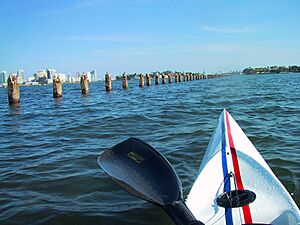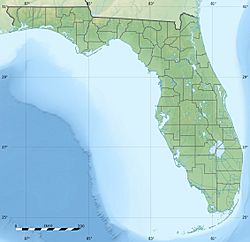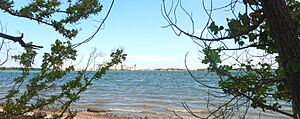Isola di Lolando facts for kids

Pilings from the Lolando Island sea wall
|
|
| Geography | |
|---|---|
| Location | North Atlantic |
| Coordinates | 25°48′15″N 80°09′30″W / 25.8043°N 80.1584°W |
| Administration | |
| County | Miami-Dade |

Isola di Lolando is an island that was never finished. It's an artificial island, meaning it was made by people, not nature. You can find it in Biscayne Bay, Florida. The project stopped because of a big hurricane in 1926 and a tough economic time called the Great Depression. Today, you can still see parts of it sticking out of the water. These parts are called pilings, and they can be dangerous for boats.
Building Islands in the 1920s
In the early 1920s, some very bold developers wanted to create new land. They would sell pieces of property in Biscayne Bay even before the islands were built! Many people wanted to buy this land.
Why Developers Built Artificial Islands
There were almost no rules about protecting the environment back then. This meant developers could imagine filling Biscayne Bay with many new islands. It seemed like there would always be more waterfront property. People thought the land boom, a time of fast growth in land sales, would never end.
The Venetian Islands Project
Two companies, The Shoreland Company and The Venetian Island Company, planned to build a chain of new islands. These were meant to be part of the Venetian Islands. They would be located south of the Julia Tuttle Causeway in northern Biscayne Bay.
Isola di Lolando's Place in the Plan
The first new island was supposed to stretch from the causeway to Di Lido Island. It was named Isola di Lolando. This name continued the "Venetian" theme of other successful artificial islands nearby.
Why the Island Was Never Finished
Several big problems stopped the building of Isola di Lolando. These events happened quickly and changed everything.
Challenges in the Mid-1920s
By 1925, many people had moved to South Florida. This rapid growth put a lot of strain on local resources. Shipping companies that moved goods by railway started to charge more money.
The Prinz Valdemar Incident
In October 1925, an old Danish warship called the Prinz Valdemar tipped over. It was in the port of Miami and was going to become a floating hotel. The ship blocked the main shipping channel for weeks. This made it hard for supplies to reach Miami.
The 1926 Miami Hurricane
The summer of 1926 brought a huge storm: the 1926 Miami hurricane. People were not ready for such a powerful hurricane. It caused a lot of damage to homes and roads. The Shoreland Company went out of business in 1927. People also started to complain about "mutilating the waterway," meaning they didn't want the bay to be changed so much.
The Great Depression's Impact
The 1929 stock market crash happened a few years later. This event started the Great Depression, a very difficult economic time. Because of these problems, Isola di Lolando was never completed.
What Remains Today
The unfinished parts of Isola di Lolando are still visible in Biscayne Bay. They are a reminder of a time when developers dreamed big.
The Visible Pilings
The Miami real estate boom ended in the mid-1920s. This happened because of economic problems and unexpected hurricanes. One failed project left its mark on northern Biscayne Bay near Miami Beach, Florida. Concrete pilings from the sea wall of the incomplete Isola di Lolando are still there. They are perfectly lined up in the shape of a new Venetian island. They stretch from the northern tip of Di Lido Island to the Julia Tuttle Causeway.
How They Look
These pilings sit in about 5 to 10 feet of water. They stick out about 5 to 10 feet above the water, depending on the tide. You can clearly see the pilings and the island's outline from the Julia Tuttle Causeway. They are also visible from many tall buildings that look out over the bay.
A Safe Spot for Wildlife
The pilings are a clear danger for boats. However, the area inside the island's outline is a peaceful place. Boats and jet skis usually avoid it. This makes it a quiet spot for kayakers. It's also a home for many animals like dolphins, manatees, stingrays, manta rays, and various types of fish.
Seeing Isola di Lolando from Space
Even though they are faint, the island's pilings and outline can still be seen from space. You can find them on online maps like Google Earth, Google Maps, and Yahoo Maps.




